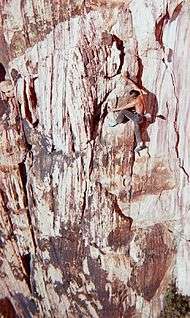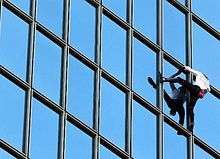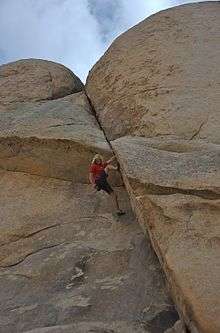Free solo climbing
| Part of a series on |
| Climbing |
|---|
 A climber free soloing at Red Rock Canyon, Nevada |
| Background |
| Types |
| Lists |
| Terms |
| Gear |
| Climbing companies |
|
Free solo climbing, also known as Soloing, is a form of free climbing and solo climbing where the climber (or free soloist) performs alone and without using any ropes, harnesses or other protective equipment, relying entirely on his or her ability instead. Unlike in bouldering, soloists typically climb above safe heights, where a fall would always result in serious injury or death. In ordinary free climbing, safety gear is used to protect from falls, although not to assist the ascent.
Motivations
Reasons for free soloing given by high-profile climbers include the simplicity and speed with which one can climb, for example Alex Honnold's two-hour-and-fifty-minute ascent of the 2,224-foot (678 m) Regular Northwest Face route on Yosemite's Half Dome, a route normally demanding multiple days.[1] Other reasons given are the intense concentration required and, for some, the adrenaline rush. The practice is mostly confined to routes familiar to the climber, whose difficulty lies well within the climber's abilities. However, inherent risks such as loose rocks or sudden change in weather are always present. Some high-profile climbers have died while free soloing, including John Bachar, Derek Hersey, Vik Hendrickson, Robert Steele, Dwight Bishop, Jimmy Ray Forrester, Jimmy Jewell, Tony Wilmott, and John Taylor.[2][3][4][5][6]
Practitioners



The sport has produced a number of well-known practitioners, made famous by photos of a climber totally alone and unprotected on sheer cliffs. Two of the most famous free soloists, Alain Robert ("The French Spider-Man"), and Dan Goodwin ("Skyscraperman"), have also scaled dozens of skyscrapers around the world — a sport known as buildering (not to be confused with bouldering) — without using any safety equipment. In June 2017, Alex Honnold made international news with the first free-solo ascent of El Capitan in Yosemite, on a route rated 5.13a in the Yosemite Decimal System.
Some climbers who are known for their regular practice of free solo climbing include: Hansjörg Auer, John Bachar, Patrick Berhault, Thomas Bubendorfer, Matt Bush, Renaldo Clarke, Peter Croft, Steph Davis, Bill Denz, Tim Deroehn, Catherine Destivelle, Patrick Edlinger, Eric Escoffier, Brad Gobright, Dan Goodwin, Mike Graham, Wolfgang Güllich, Colin Haley, Derek Hersey, Alex Honnold, Alexander Huber, Jimmy Jewell, Eric Jones, Kevin Jorgeson, Ally Law, Matt Lloyd, Dave MacLeod, Dan Osman, Dean Potter, Paul Preuss, Andreas Proft, Herbert Ranggetiner, Michael Reardon, Alain Robert, Tobin Sorenson, Will Stanhope, Ueli Steck, Slavko Svetičič, Miroslav Šmíd, Akihira Tawara, John Yablonski, Maurizio Zanolla.
Some climbers who occasionally or rarely free solo climbed, but have been influential to the practice, include: Pierre Allain, Henry Barber, Lynn Hill, Ron Kauk, Jean-Christophe Lafaille, John Long, Dave MacLeod, Reinhold Messner.
Difficult free solo ascents
There are few climbers who have free solo climbed in the 5.14 grade range. This list does not include "highball" boulder ascents because the climbers here did not use any padding or spotters. There is some debate on the blurred line between "highball" bouldering and short free solo climbs.[7]
- 5.14b (8c) - Darwin Dixit (50 ft) - Margalef, Spain - Dave MacLeod, March 2008.[8]
- 5.14a (8b+) - Kommunist (22m) - Tyrol, Austria - Alexander Huber, 2004. The first 5.14 free solo.[9]
Notable accidents
- Paul Preuss (October 3, 1913) died during an attempt to make the first ascent of the North Ridge of the Mandlkogel free solo, fell more than 300m.
- Jimmy Jewell fell to his death (October 31, 1987) from Poor Man's Peuterey (Severe) at Tremadog, North Wales. He was using the route as a shortcut from a local pub to his climbing club hut; the route was well below his usual grade and capability.
- Derek Hersey died (May 28, 1993) in an accident while soloing the Steck-Salathé Route free solo, on Sentinel Rock in Yosemite National Park.
- Dwight Bishop fell (July 19, 2004; age 49) climbing alone and unroped, Wyoming, Grand Teton National Park, The Grand Traverse.
- Jimmy Ray Forester fell (November 24, 2006; age 43) while free-soloing in El Potrero Chico, Mexico. Forester, an experienced, talented climber, failed to return to camp after setting out on The Scariest Ride in the Park, a 40-pitch 5.9 ridge route known for loose rock. He was found the next day at the base of the wall.[10]
- George Gardner fell to his death (July 25, 2008; age 58) while free soloing in Grand Teton National Park.[11]
- John Bachar died (July 5, 2009) in a free solo accident at Dike Wall near Mammoth Lakes, California.
- Akihira Tawara died (September 13, 2011) while free solo climbing the Directissima 5.8 route on Yamnuska.
- Michael Ybarra died (July 2012) climbing solo on The Matterhorn Peak in California's Sierra Nevada Mountains.[12]
- Brad Parker fell (August 2014) about 300 feet to his death while attempting to climb Matthes Crest Traverse in Yosemite, CA.[13]
- Andrew Barnes died (June 12, 2015; age 46) falling 50 ft (15 m) free solo climbing in New York's Shawangunk Mountains.[14]
- Angus Moloney died (September 27, 2015; age 22) falling 100 ft free-solo climbing from the Fifth Pinnacle above the Gregory Canyon Trail, Boulder's Open Space and Mountain Parks.[15]
- Ueli Steck, a world renowned Swiss Free Solo climber, died after falling an estimated 1000m while trying to scale the Nuptse Wall on April 30, 2017.
Alternatives
Alternatives to free soloing include:
- Free climbing with the use of ropes to catch a fall.
- Bouldering: climbing at heights low enough that a fall would normally be safe, typically making use of a bouldering mat to cushion a potential fall.
- Deep water soloing: climbing over a body of water.
- Free BASE: a combination of free solo climbing to ascend a structure, and BASE jumping with a parachute to descend.
References
- ↑ Archived 29 December 2010 at the Wayback Machine.
- ↑ Perrin, John (2006). The Climbing Essays. Neil Wilson Publishing Ltd. p. 320. ISBN 9781903238479.
- ↑ Pearsons, Neil. "Abandon all rope part 2". The Guardian. Retrieved 18 August 2012.
- ↑ "Jimmy Ray Forester Killed in Solo Fall". Rock and Ice. 2009. Retrieved 17 January 2015.
- ↑ Ghiglieri, Michael Patrick (2004). Off The Wall: Death in Yosemite. Puma Press. p. 608. ISBN 9780970097361.
- ↑ Staff (25 July 2004). "Dwight Bishop, 48". The Montana Standard. Retrieved 18 August 2012.
- ↑ "Kevin Jorgeson Sends Ambrosia and Blurs Line Between Highball and Free Solo". 11 January 2009. Retrieved 13 December 2017.
- ↑ "MacLeod Solos 5.14b in Spain". Retrieved 13 December 2017.
- ↑ "Solo, Part IV: Alexander Huber - Alpinist.com". www.alpinist.com. Retrieved 13 December 2017.
- ↑ "Jimmy Ray Forester Killed in Solo Fall". Rockandice.com. 2010-11-30. Retrieved 2015-10-09.
- ↑ "Did Gusty Winds Cause a Fatal Climbing Accident at Grand Teton National Park? - National Parks Traveler". www.nationalparkstraveler.com. Retrieved 13 December 2017.
- ↑ Scott C. Johnson. "Michael Ybarra's Death Underscores the Allure and Dangers of Solo Climbing". The Daily Beast. Retrieved 2015-10-09.
- ↑ Barmann, Jay (20 August 2014). "Experienced Rock Climber Falls To His Death In Yosemite Free Climb After Proposing To Girlfriend". SFist. Archived from the original on 11 January 2016. Retrieved 9 October 2015.
- ↑ "Schenectady County rock climber dies in fall at nature preserve". Retrieved 13 December 2017.
- ↑ Gugala, Jon (7 October 2015). "Free-Solo Climber Falls to Death Near Boulder - Outside Online". Retrieved 13 December 2017.
Further reading
- The High Lonesome: Epic Solo Climbing Stories, John Long. ISBN 1-56044-858-X
- Ament, Pat (2001). A History of Free Climbing in America
External links
- Edge of Oblivion - Free-solo rock climbers feel spiritual lure, Sheila Mulrooney Eldred. Fresno Bee, 8 April 2004